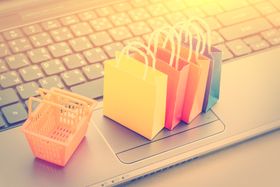Personalization Technology in 2025 Explained (+ Upcoming Trends)
Discover how personalization technology is transforming businesses, boosting user engagement, and shaping future trends.
Updated December 5, 2024.

Studies have shown that over 70% of customers expect personalized interactions and are likelier to finalize their purchases when provided with such customization.
As the world increasingly digitizes, personalization technology is swiftly becoming a key driver of revenue growth across various sectors, including eCommerce, marketing, education, and entertainment. This technology uses data to create the ultimate personalization experience for your shoppers, meaningfully helping businesses connect with customers to provide tailored experiences.
» Start at the beginning: What is personalization in eCommerce?
Meet the Expert
Jameela Ghann is an eCommerce and marketing expert with more than 10 years of experience. Apart from running her own successful online store, Alora Boutique, she's the marketing manager of Fera.ai.
Personalization Technology in eCommerce
Personalization technology in eCommerce refers to the use of data to create unique user experiences. This can be compared to crafting a tailor-made gift or addressing a wedding invitation by hand. Brands use this technology by collecting and analyzing data related to consumer identity and behavior, such as:
- Demographics (age, nationality, etc.)
- Past purchases
- Browsing history
- Preferences
Benefits of Personalization Technology
- Enhanced user engagement: Personalization keeps users more engaged by delivering tailored content, leading to longer site visits and more interaction.
- Increased spending potential: Personalized product recommendations and quizzes encourage users to spend more, boosting sales.
- Simplified decision-making: Tailored options make it easier for customers to find what they need, increasing the likelihood of purchase.
- Improved brand perception: Personalization makes customers feel valued and understood, boosting their satisfaction and loyalty.
- Greater customer lifetime value: By offering personalized content and offers, businesses can drive repeat purchases and increase overall value.
» Discover the differences between B2C and B2B personalization
Leveraging Data Through Machine Learning
Collecting the right data allows you to better segment your audience and showcase the right products and information to the right customers at the right time.
Data collection for personalization involves explicit and implicit data.
Explicit data includes information willingly provided by users, like:
- Survey and questionnaire responses
- Account registration information (name, email, demography)
- Preferences stated during sign-ups (e.g., newsletter topics)
- Feedback provided through customer service interactions
Implicit data, on the other hand, encompasses:
- Purchase history and patterns
- Page view analytics on a website
- Time spent on specific content or pages
- Engagement metrics with emails or social media posts (e.g., opens or clicks)
Machine learning and AI are essential for interpreting and utilizing this data effectively. Algorithms play a key role in streamlining the analysis process to understand user intent, audience segments, and behavior. Tools like Fast Simon or Fera.ai leverage machine learning to segment customers based on available data, enabling content customization that facilitates upsells, cross-sells, and streamlined site merchandising that's unique to everyone.
Pro tip: Utilizing AI and machine learning may be crucial for effective personalization, but you shouldn't stop there. Conduct regular A/B testing to help you fine-tune strategies and ensure optimal customer experiences.
» Read more: 6 Benefits of using AI in eCommerce personalization
Don't Forget About Omnichannel Personalization
Predictive personalization should extend beyond websites to create a seamless omnichannel experience across various touchpoints, including email, social media, and even physical stores.
Small and mid-sized businesses are increasingly adopting multi-channel merchandising and personalization to provide a holistic view of their customers. By combining data from various sources—such as website behavior, social media engagement, and offline purchases—they can deliver a truly integrated and customized experience that fosters loyalty and drives sales.
However, as businesses incorporate omnichannel personalization, they must remain mindful of ethical and legal considerations:
- Transparency: Be clear about how customer data is collected and utilized to build trust.
- Opt-out options: Provide customers with the ability to refuse data collection, ensuring control over their personal information.
- Regional law compliance: Adhere to data protection laws specific to each region to ensure compliance and safeguard customer privacy.
» Learn more: Creating an omnichannel strategy for your business
Personalization Examples Beyond eCommerce
Personalization is becoming so prevalent in modern sales and marketing practices that it extends far beyond eCommerce into almost every industry that has a vendor-consumer relationship.
Duolingo
Duolingo, is an online language learning platform, that uses adaptive lessons to cater to individual learning styles. When a user breezes through lessons, Duolingo adjusts the difficulty level to keep users stimulated.
Coursera
Platforms like Coursera make course recommendations based on the user's interests.
Netflix
Streaming services like Netflix also employ personalization technology to suggest shows and movies based on the viewer's preferences.
Flix Health
Even in medicine, personalization plays a significant part as health groups like Flix Health, a Canadian company led by a biomedical technology PhD holder, use machine learning to personalize medicine.
Remember that caution is necessary when using personalization tools—An AI chatbot error led to a legal case, where Air Canada faced consequences for providing incorrect information regarding bereavement discounts. The AI hallucinated an answer and ended up costing the airline almost $1,000 after it was taken to court.
» Check out these eCommerce personalization strategies to help you boost your sales
Looking Ahead: Personalization Trends in 2024
In 2024, the landscape of personalization is set to greatly evolve, thanks to significant advancements in artificial intelligence (AI) and machine learning, coupled with strides in processing chips and data analysis capabilities. These improvements are expected to lower the costs associated with AI, enabling more precise personalization techniques available for businesses of all sizes.
This development opens up opportunities for hyper-personalized, real-time interactions that feel specially customized for each user. It goes beyond traditional recommendations that are based on past behaviors and incorporates dynamic factors like location, time, and ongoing localized events.
The concept of contextual awareness is central to these advancements. As technology becomes more adept at interpreting various contexts—considering not just who the user is, but where they are and what they're doing—personalization can be incredibly nuanced.
Example: Consider a fitness app that adapts workout recommendations based on your goals, the weather, and your location. For example, it might suggest an outdoor run in a nearby park on a sunny day or a home-based workout when it's raining, providing you with the best possible unique advice in all situations.
» Personalize the customer experience by enhancing your site search functionality
The Power of Personalization
Personalization technology has the potential to revolutionize the business landscape by fostering deeper connections with customers, reducing cart abandonment, enhancing user engagement, and boosting conversions and sales. Whether a small eCommerce owner or a multinational corporation, understanding and harnessing this technology can give your business a competitive edge in the digital age. The future of personalization looks promising, and those who adapt quickly to this trend of AI-powered technologies are likely to thrive in the coming years.
As customer expectations continue to evolve, businesses that prioritize personalized experiences will build stronger brand loyalty and increase customer retention. By leveraging data-driven insights, companies can deliver tailored experiences that not only meet but exceed customer expectations.
» Schedule a demo to get started with your own eCommerce personalization tool









